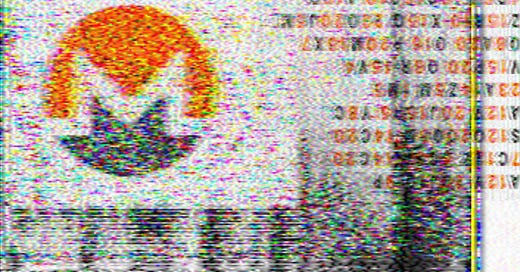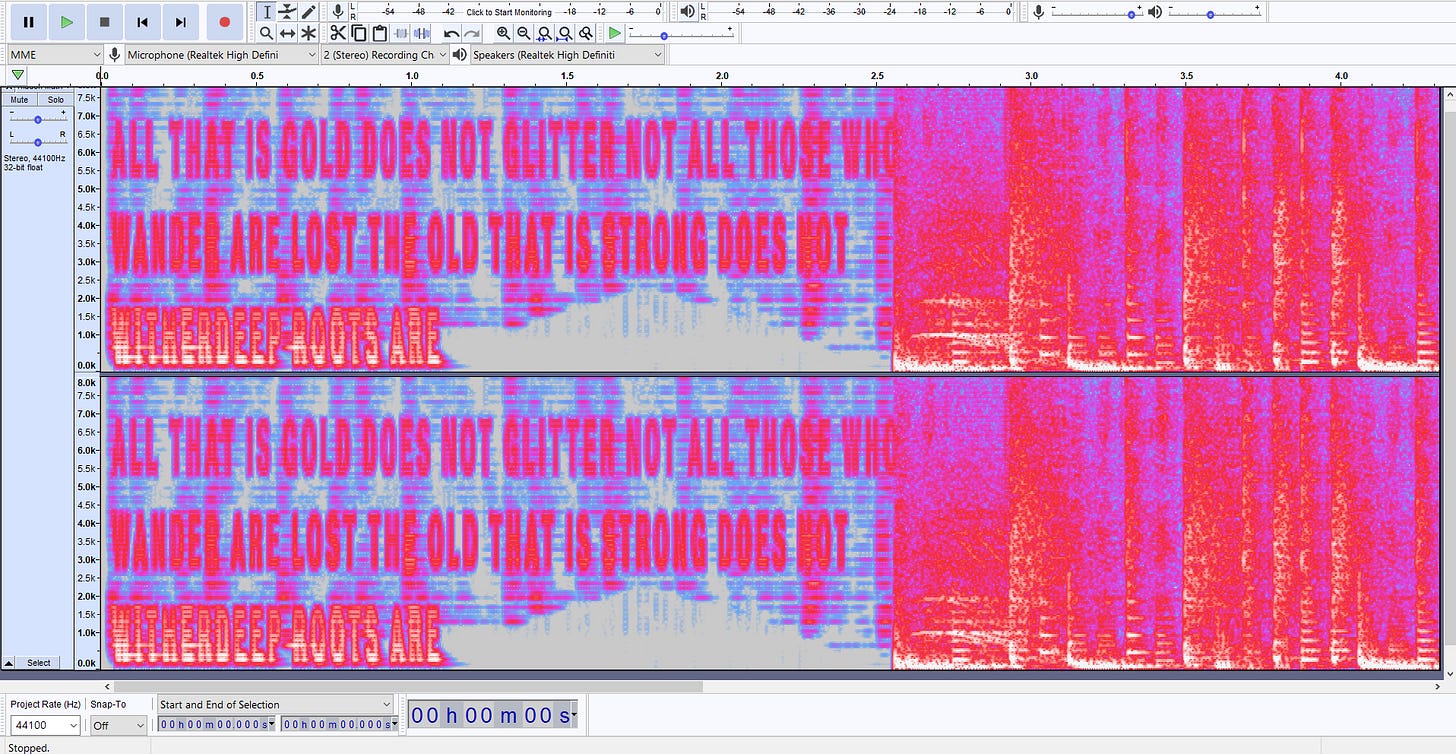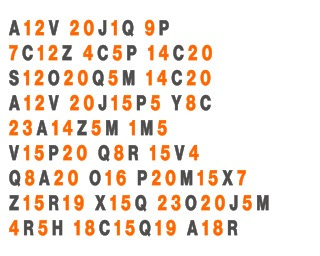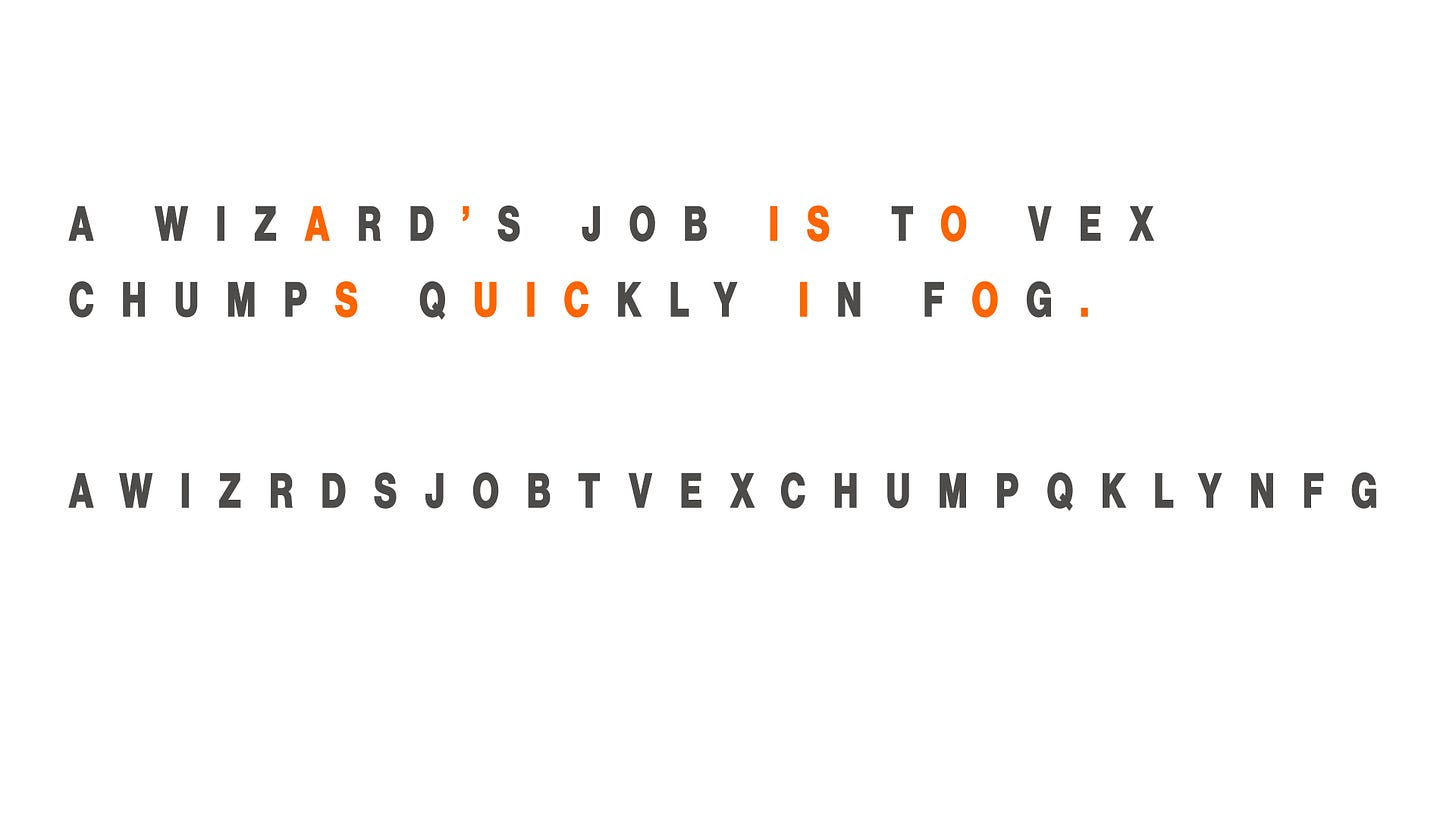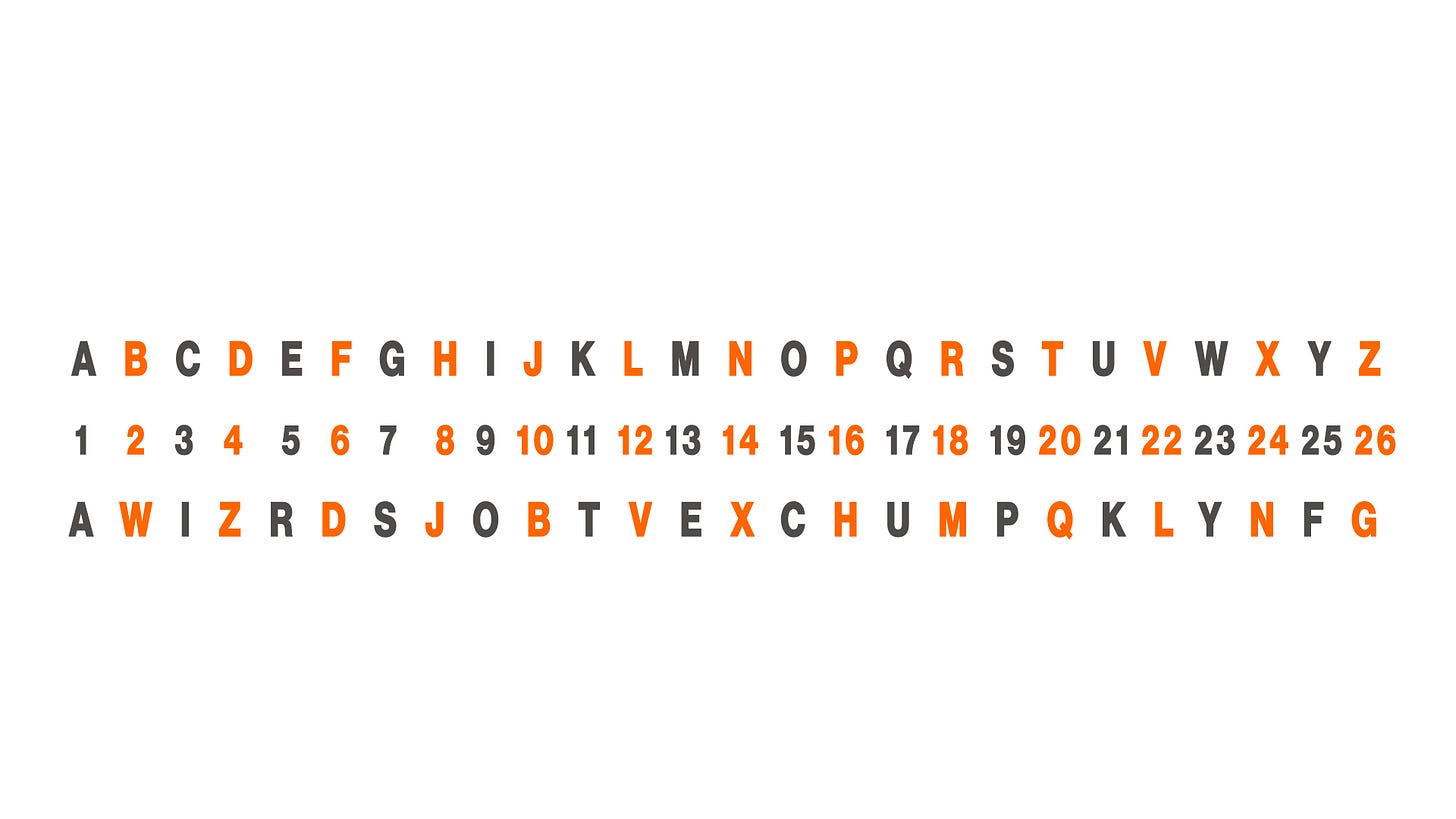How To Hide Your Monero Seed In Audio Files
Using Additive Image Synthesis or SSTV with Monoalphabetic Ciphers
The image above shows a folder of free audio tracks that anyone can download from the YouTube Audio Library.
These files are royalty-free and have likely been downloaded by millions of people. The presence of these files on someone’s system generates no suspicion for anyone who creates YouTube videos.
What if I were to tell you that in this innocuous album is hidden my 25-word Monero seed phrase?
You probably would never have suspected this unless I had revealed it to you.
Thus, my seed is perfectly hidden in plain sight.
What if I told you that it is also hidden in such a way as to be impervious to word searches?
Even better, right?
In this article, I’m going to show you how to craft a digital backup of your seed phrase by utilizing a mixture of the following:
Steganography
Additive Image Synthesis
Slow-Scan Television (SSTV)
Pangramic Monoalphabetic Numeral Encryption
Don’t be put off by those long technical terms, this is all rather straightforward and I’m here to help every step of the way should you need assistance.
So with that said, go grab a coffee (or a tepid glass of water if it’s past your bedtime), and let’s dive in!
Keep It Secret, Keep It Safe
Gandalf’s advice to Frodo to keep the Ring of Power in his possession secret and safe is sound advice. The misappropriation of The One Ring could have disastrous results (like the end of everything fair and beautiful).
In a slightly less dramatic sense, your seed phrase is going to be the #1 target for thieves and should be kept secret and safe.
Physical safes or even hardware wallets such as the Nano Ledger are obvious attack points for thieves as their very existence demonstrates a need to protect something of potential value.
Some of these devices can even be subject to unique attacks such as power surges via USB:
Your best strategy, therefore, when choosing to digitally back up your seed phrase is to inconspicuously hide it in plain sight.
Keep it secret, keep it safe.
All That Is Gold Does Not Glitter
Continuing with The Lord of The Rings analogies (this all has significance, trust me, okay?), this “hidden in plain sight” philosophy was personified in Strider, a dirty vagabond who was, in fact, the rightful king of Gondor.
It was Strider’s unkept aesthetic that allowed him to evade detection by the enemy, even generating mistrust from allies such as Frodo.
Within the novel The Fellowship Of The Ring, Gandalf’s instructive letter to Frodo at the Prancing Pony Inn to trust Strider despite his unappealing and unkept exterior is communicated in the famous poem:
All that is gold does not glitter,
Not all those who wander are lost;
The old that is strong does not wither,
Deep roots are not reached by the frost.
From the ashes a fire shall be woken,
A light from the shadows shall spring;
Renewed shall be blade that was broken,
The crownless again shall be king.
Steganography is the ability to conceal the very existence of a message physically, with techniques such as invisible inks, microdots, etc.
In our examples below, we will be leveraging Additive Image Synthesis and SSTV to do this.
We are going to make sure your Monero gold does not glitter.
Additive Image Synthesis
Most synthesizers are subtractive, meaning that they remove harmonics from the sonic spectrum to generate various sounds. Alternatively, there are additive synthesizers that create harmonics.
The neat thing about additive synthesizers is that you can turn any sound into an instrument!
The other cool thing is that you can transform images into sounds or burn images into audio files.
I used Harmor to do this in FL Studio Producer Edition which will set you back about £234.
Otherwise, there is Coagula, a free additive synth that you could experiment with (I have not looked into this in any great detail).
Choosing Your Song
Using the first 25 words of the poem above as my example Monero seed, it’s time to find a song to hide in.
I chose to hide my theoretical LOTR seed phrase in the “O Boy” track due to the strange 90s techno intro that it has (see below)
Original Song - Jeremy Black - O Boy (Sample)
This strange assortment of sounds is the perfect place to hide image synthesis which leaves a “robotic bee” sound when implemented.
Here is my version using image synthesis:
25-Word Seed Hidden With Image Synthesis
The song’s drop also makes me feel like a cypherpunk hacker from the 90s with an ear piercing and dragon tattoo.
Alternatively, you could hide the “robotic bee” sound of the synthesis later in the song or audio file (think long podcast) at a timestamp that makes sense to you.
This modified audio file (make sure to retain the metadata on export) now contains my seed phrase which can be seen via the Spectrogram view in free audio editing software like Audacity, Adobe Audition (if you have a subscription), or FL Studio using the Wave Candy plugin.
Neat, right?
Well, let’s say you want to hide your seed phrase in an audio file but you don’t want to spend the time to learn complex software while forking over +£200.
Introducing my next solution…
SSTV
SSTV uses radio signals or audio to transmit small visual images. In fact, the International Space Station still uses this tech to transmit images!
If you really want to, you could transmit your SSTV signal via radio and pick it up by a receiver elsewhere in the world (note that this is public so would need to encrypt your seed first - more on that later).
For our purposes, we are going to generate an SSTV audio file from an image of our seed. This way we can still name and hide our SSTV audio file in our fake YouTube Audio folder.
First, you will need to create a Monochrome Bitmap image of your seed (.bmp) at a resolution of 320x256 with a depth of 24-bits. I found that the easiest way to do this is through Microsoft Paint (file > properties), I’ve attached my example below:
Next, you will want to download the free VE3NEA SSTV Tools and use the SSTV Signal Generator to create your SSTV .wav audio file (it will sound like dial-up on steroids).
To decode your SSTV .wav file back into an image, you will then need to use the Black Cat SSTV app which will cost you $20 (there is a free trial you can use too). Since the app is closed source, I would recommend manually encrypting your seed before doing this (you should also manually encrypt your seed before using image/ audio editing software - more on this later).
What is super cool about this SSTV method is that you can effectively break the digital footprint of your transmission.
Using Black Cat SSTV, you can open the microphone on your webcam and receive the audio transmission by playing the audio over a speaker.
For example, if you were really committed, you could record your SSTV .wav file using an old-fashioned tape recorder and then play it back at a later date via the mic transmission on Black Cat SSTV.
Below is an example of me using the speakers on my mobile phone to output my SSTV .wav file that I sent to myself via Session while the laptop microphone (which is not very good) decodes the audio in the Black Cat SSTV app!
The seed was encrypted with the technique described next.
**NOTE Very Loud - turndown speakers before playing!**
SSTV .wav file used to create the image above
Encryption Methods
Let’s assume someone is familiar with SSTV or Additive Synthesis, all they would have to do is process your audio file once discovered, and presto, your seed has been compromised.
For this reason, I would strongly suggest first manually encrypting your seed before using one of the techniques described previously.
Next, I’ll outline one super simple encryption method that I incorporated into my existing LOTR seed example.
Pangramic Monoalphabetic Numeral Encryption
A pangram is a sentence that utilizes every letter of the alphabet. A common example on any typeface website would be:
The quick brown fox jumps over the lazy dog
others include
Farmer Jack realized that big yellow quilts were expensive.
How quickly daft jumping zebras vex!
When zombies arrive, quickly fax Judge Pat
and my personal favorite:
A wizard’s job is to vex chumps quickly in fog.
Once we have selected our desired pangram, we want to link each sequential alphabetical letter in the sentence to the alphabet.
First, punctuation should be removed, then duplicate letters:
now we can match the alphabet
abcdefghijklmnopqrstuvwxyz
against the remaining letters in our pangram sentence
awizrdsjobtvexchumpqklynfg
Now using the above sequence or key, we can map out the encrypted text of our example 25-word seed:
all that is gold does not glitter
not all those who wander are lost
the old that is strong does not wither
deep roots are
Resulting in:
avv qjaq op scvz zcrp xcq svoqqrm
xcq avv qjcpr yjc yaxzrm amr vcpq
qjr cvz qjaq op pqmcxs zcrp xcq yoqjrm
zrrh mccqp amr
This text could then be used in your additive image synthesis or SSTV obscuration, all you would need to do is remember your witty pangram keyphrase to decipher the text.
You could also add an extra layer of complexity by replacing every other letter with its numeral equivalent:
Now that’s what I call Pangramic Monoalphabetic Numeral Encryption!
For more simple yet robust encryption methods, such as polyalphabetic ciphers, I would recommend reading the introductory chapter to Cosmic Codes which outlines a short, yet detailed history of encryption and ciphers.
If you have any questions about implementing any of this, please leave a comment below and I’ll try my best to get back to you.
Alternatively, if you want me to process your encrypted seed into an audio file using additive synthesis, or generate an SSTV-ready audio file on your behalf you can place an order with me here.


